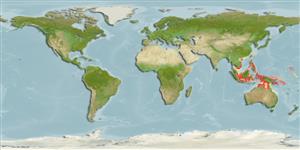>
Acanthuriformes (Surgeonfishes) >
Ephippidae (Spadefishes, batfishes and scats)
Etymology: Rhinoprenes: Greek, rhinos = nose + Greek, prenes = the front part of a body (Ref. 45335).
Environment: milieu / climate zone / depth range / distribution range
Écologie
marin; saumâtre démersal. Tropical
Western Pacific: Papua New Guinea to northern Australia.
Taille / Poids / Âge
Maturity: Lm ? range ? - ? cm
Max length : 15.0 cm TL mâle / non sexé; (Ref. 245)
Épines dorsales (Total) : 8; Rayons mous dorsaux (Total) : 19 - 20; Épines anales: 3; Rayons mous anaux: 16 - 17. Body deep and compressed, quadrangular in outline. Mouth small and inferior. Second dorsal spine, fourth pectoral ray, and first pelvic ray greatly prolonged into free filaments which reach tail base or beyond. First dorsal-fin spine, fourth pectoral-fin ray, and first pelvic-fin ray greatly elongated filaments, reaching to or beyond vertical line at rear end of dorsal-and anal-fin bases. Head naked. Mouth inferior, the snout and upper jaw projecting in front of lower jaw (Ref 43039).
Feeds on algae and sewage (Ref. 4537).
Life cycle and mating behavior
Maturité | Reproduction | Frai | Œufs | Fécondité | Larves
Nelson, J.S., 1984. Fishes of the world. 2nd edition. John Wiley & Sons, Inc., New York. 523 p. (Ref. 245)
Statut dans la liste rouge de l'IUCN (Ref. 130435: Version 2024-2)
Menace pour l'homme
Harmless
Utilisations par l'homme
Pêcheries: sans intérêt
Outils
Articles particuliers
Télécharger en XML
Sources Internet
Estimates based on models
Preferred temperature (Ref.
123201): 26.9 - 28.8, mean 28 °C (based on 232 cells).
Phylogenetic diversity index (Ref.
82804): PD
50 = 1.0000 [Uniqueness, from 0.5 = low to 2.0 = high].
Bayesian length-weight: a=0.02692 (0.01132 - 0.06402), b=2.94 (2.74 - 3.14), in cm total length, based on LWR estimates for this (Sub)family-body shape (Ref.
93245).
Niveau trophique (Ref.
69278): 2.0 ±0.00 se; based on food items.
Résilience (Ref.
120179): Haut, temps minimum de doublement de population inférieur à 15 mois (Preliminary K or Fecundity.).
Fishing Vulnerability (Ref.
59153): Low vulnerability (10 of 100).
